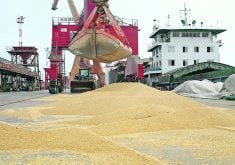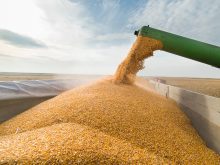Most of the wild and exciting ride is probably over, but oats growers can savour the return of a market that isn’t glutted, say oat buyers.
“The market will likely settle down some,” said Dennis Galbraith, manager of procurement for Can-Oat Milling.
“But we have really turned the corner from being in a continually burdensome oversupply market to what appears to be a market that’s nicely balanced between supply and demand.”
That means prices could move on news of weather or supply changes.
Read Also

Flax sector sees omega-3 opportunity
SASKATOON — A global shortage of omega-3 oils could be an opportunity for the flax sector, says an industry official….
“This might be termed a broker’s dream. There are some very bullish people and some mildly bearish people,” said Galbraith.
“Brokers would love that kind of a market because they could trade all day.”
Beginning in late April, cash oat prices rose strongly in comparison to futures as buyers reacted to drought in Western Canada where the bulk of the North American milling oat crop is grown.
Oat futures started rising in late June.
But traders say these two phenomena occurred for different reasons. Cash prices jumped because some mills or people who had contracted to supply mills were short of oats and got scared by reports of significant drought in Saskatchewan.
As buyers tried to lock down supplies of old-crop Canadian oats, many farmers reacted by hanging on and hoping prices would go higher. That caused the upsurge in cash prices.
“It’s not unlike a feeding frenzy with sharks,” said Galbraith.
“When there’s blood in the water and farmers can smell it, they sit tight and everyone gets panicky.”
Agricore oat trader Len Karnafel said all the panic buying gave a bonus to farmers who sold.
But the buying frenzy has already cooled off.
Galbraith said some millers in the United States are buying new-crop U.S. oats, which are beginning to come off the fields. That means buyers aren’t as scared any more.
“They’re not in a panic to chase old-crop Canadian,” said Galbraith.
“They do want Canadian oats, but they’re prepared to use American oats until the Canadian harvest gets into full swing and they get down there.”
The recent rise in oat futures was not due to Canadian drought worries, but to American corn belt heat wave problems, Galbraith said.
“The corn ran up and dragged the oat futures with it,” he said.
There have been two heat scares in the U.S. Midwest in July, but traders relaxed a little late last week, lowering the corn market and taking oats with them. But if something hurts the corn crop again, oats should go along for the ride
“The U.S. corn crop is the big question,” said Galbraith.
“If corn takes off, it’ll drag all the feed grain complex with it.”
Also, the oat market will continue to be unstable until the size of this year’s oat crop is known, said Karnafel and Galbraith.
“There’s a lot of uncertainty about the size and quality of the crop that’s got everyone nervous here,” said Karnafel.
Also, many in the industry believe Statistics Canada’s ending stocks number of 700,000 tonnes for 2000-01 is too high, but no one has a better survey on which to rely.
The trade will be watching to see how much is still sitting in farmers’ bins.
Getting a sense of the size of the coming Canadian crop is difficult, said Galbraith, who has toured Saskatchewan and Manitoba to check on the crop.
The drought in Saskatchewan and Alberta appears not to have ravaged the milling crop, since it is not generally grown in the hot zone between Saskatoon, Regina and Red Deer.
Crops on the fringe of that area, between Saskatoon and Prince Albert and Melfort have suffered, but are doing better than wheat and canola crops that were seeded later.
“The plant that’s there got the rain and it’s going to be able to fill every kernel that it’s got very nicely,” said Galbraith.
Many crops in southwestern Manitoba and southeastern Saskatchewan look good.















